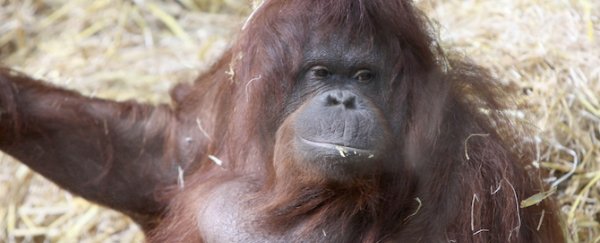A female Bornean orangutan living at Cologne Zoo in Germany has figured out how to make human-like calls in order to grab the attention of her keepers when she wants more food.
Named Tilda, she is the fist wild-born orangutan ever known to make human vocalisations, and the ability suggests that other great apes, as well as our ancestors, could have had the same ability.
Although orangutans are known to have highly diverse and unique vocalisations, Tilda produces two calls that are unknown among other orangutans. The first one involves her clicking her tongue to create a sound comparable to our pronunciation of voiceless consonants - as you can see in the video below, it's similar to the clicking used by the Bushmen of the Kalahari Desert in Africa.

The second call is a quick succession of grumbles that almost sound like vowels.

Tilda can also whistle, and it's believed that she learned all these calls from a trainer while working in the entertainment business.
Tilda's vocalisations have now been described in a paper in PLOS ONE, where lead author, biologist Adriano Lameira from the University of Amsterdam, explains that she has a very clear purpose for using them - to get more food.
The researchers worked this out after noticing that she also claps or points at food while making the vocalisations, Lameira told Jennifer Viegas from Discovery News.
"They are what we would call attention gathering or come-hither calls, which indeed are mostly used when the human caretakers are handling food," Lameira told Viegas. "I would translate them into, 'Come here and give that food to me!"
But the vocalisations don't just prove that Tilda is one savvy ape - it also confirms that great apes, and their common ancestors, have the ability to produce human-like calls.
"The extent of motoric control that great apes exert over their vocal structures, both laryngeal and supra-laryngeal, may be much higher than hitherto presumed," the authors write in PLOS ONE.
"The notion that great ape calls are hard-wired and inflexible is likely an artefact of our very poor understanding of the call communication of these species, rather than that their calls are factually hard-wired or inflexible," Lameira added to Viegas.
Importantly, the research could help us understand the origins of human speech.
Although Tilda is the first wild-born orangutan to make human vocalisations, another adult called Bonnie, who lives at the National Zoo in DC, has also taught herself to whistle, seemingly just for the pleasure of it. Chimpanzees and gorillas have also been shown to chatter like humans.
"What Bonnie shows is that anatomically, whistling would have been in the range of potential sound making behaviour of Archaic Homo sapiens, including Neanderthal and earlier hominins like Homo erectus and Australopithecines," linguist Mark Sicoli told Viegas.
This means that by further investigating how great apes use vowel- and constant-like calls both in the wild and captivity, we may come closer to figuring out for the first time "the conditions that brought together for the first time the two basic building blocks of speech," as the researchers write.
If all this isn't impressive enough, scientists have also recently discovered that monkeys can learn to recognise themselves in the mirror. And they've also proved that this chimp, called Ayumu, has insane visual processing speeds that we could only dream of.

Source: Discovery News, PLOS ONE
